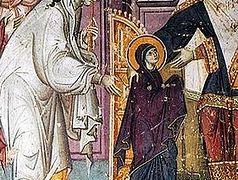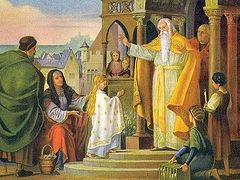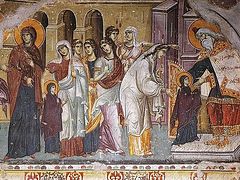On December 4, the Church commemorates the Entrance of the Most Holy Theotokos Into the Temple—an event connected with the vow of her parents, Sts. Joachim and Anna. They led their three-year-old daughter Mary to the Jerusalem Temple, where she was led by the High Priest Zacharias into the Holy of Holies and was brought up until the age of twelve. On this Great Feast, we offer our readers a theological-philological commentary on the troparion for the day.
The peculiarity of this feast is that it is based on the apocrypha—the Protoevangelium of James. This tradition has sufficient authority, since it was used by the holy fathers:
The antiquity of the Protoevangelium of James can be seen from the testimonies of the ancient fathers and teachers of the Church. Beginning in the fourth century, we find a continuous series of references to it in St. Gregory of Nyssa († 394), St. Epiphanius of Salamis († 403), in the hexaemeron attributed to Eustathius of Antioch, in St. Andrew of Crete, and others. In his Homily on the Nativity of Christ, St. Gregory of Nyssa mentions that the parents of the Mother of God were barren to old age, then received a daughter by their prayers, referring to the fact that he heard a certain apocryphal story with such a narration about her (Mary).1
In some eighth-century menaions, you can find only brief references to this feast, which speaks to the absence of any special solemnity in its celebration.2 There are homilies dedicated to the feast known from the eighth century, attributed to Patriarch Germanos of Constantinople († 740), and there are homilies of Patriarch Tarasios († 806) preserved from the ninth century.3
The feast’s active development began in the ninth century. The stichera at the litia and canon for the feast in Matins were written by St. George of Nicomedia. The second canon was composed by Basil Pagariot, the Archbishop of Caesarea. According to Theodore Prodromos (twelth century) and Nikephoros Kallistos (fourteenth century), the feast was not included among the Twelve Great Feasts before the fourteenth century.4 At the same time, in the Studite and Jerusalem Typikons of the eleventh to fourteenth centuries, the Entrance Into the Temple was celebrated just as solemnly as the other Twelve Great Feasts. However, all the way up to the seventeenth century, the Typikons preserved the features of the feast of the Entrance indicating that it was lesser in solemnity than the other of the Twelve Great Feasts.5
Here is the text of the troparion in Greek:
Σήμερον τῆς εὐδοκίας Θεοῦ τὸ προοίμιον, καὶ τῆς τῶν ἀνθρώπων σωτηρίας ἡ προκήρυξις. Ἐν Ναῷ τοῦ Θεοῦ τρανῶς ἡ Παρθένος δείκνυται, καὶ τὸν Χριστὸν τοῖς πᾶσι προκαταγγέλλεται. Αὐτῇ καὶ ἡμεῖς μεγαλοφώνως βοήσωμεν· Χαῖρε τῆς οἰκονομίας τοῦ Κτίστου ἡ ἐκπλήρωσις.
And in Church Slavonic:
Днесь благоволения Божия предображение и человеков спасения проповедание, в храме Божии ясно Дева является и Христа всем предвозвещает. Той и мы велегласно возопиим: радуйся, смотрения Зиждителева исполнение.
There are several translations of the troparion into English. The version on the site of the Orthodox Church in America reads:
Today is the prelude of the good will of God, of the preaching of the salvation of mankind. The Virgin appears in the Temple of God, in anticipation proclaiming Christ to all. Let us rejoice and sing to her: Rejoice, O fulfillment of the Creator’s dispensation.
The prelude of the good will of God
At the Nativity of the Most Holy Virgin Mary from Joachim and Anna, only Anna, due to the miraculous circumstances that accompanied this birth, could foresee the great fate of her daughter.6
In our previous commentary on the feast of the Protection of the Most Holy Theotokos, we already spoke about the peculiarity of the word “today.”7 We are transported to the Temple, where together with the High Priest Zacharias, we meet the Most Holy Virgin.
“The prelude of the good will of God” means “an omen, a preliminary overview, an introductory discourse”8 on the good will of God for mankind, that has consciously rejected Him, the absolute Source of goodness. He gives a chance, through the Incarnation of God the Word, to those people who want to return to Him. For them, the entrance of the Virgin Mary into the Jerusalem Temple is the prelude of God’s mercy, God’s good will towards man.
It’s worth turning to the Greek original. The dictionary of I. K. Dvoretsky gives the following definitions of the word “προοίμιον” (prelude):
-
entrance, introduction;
-
opening hymn, prelude;
-
a song of praise, hymn;
-
beginning.9
The Entrance of the Mother of God into the Temple was her manifestation to the world, like Christ’s manifestation at Theophany. Therefore, it was a silent preaching to the people of the imminent coming of Christ, Who returns grace to mankind. God serves men and their salvation, and the Theotokos is the incarnation of all of the Creator’s plans for men.10
The Virgin appears in the Temple of God
The Most Holy Theotokos’ parents gave a vow that were they to have a child, they would dedicate it to the service of God. They received that which they prayed for. And as honorable and God-pleasing parents, they brought the divine maiden, the chosen Virgin and Mother of God to the Temple. St. Gregory Palamas points out that at an early age, the Virgin Mary, having Divine gifts, possessed a mature mind and understood the significance of what was being done with her at that time, showing that she came to God of her own will.11
The High Priest Zacharias, seeing this and realizing that Mary had Divine grace, brought her into the Holy of Holies. He assured everyone that what was happening was the will of God. Angels would bring her unknown food that strengthened her spirit and body, since Mary entered the Holy of Holies not temporarily, but remained living there until a specific time.12
Therefore, the troparion says: “The Virgin appears in the Temple of God.”
In anticipation proclaiming Christ
The event of the Entrance of the Most Holy Theotokos into the Temple leads people to the Nativity of Christ even more than her Nativity. By the time of the feast of the Entrance, the Nativity of Christ is already especially felt.
That means the troparion could not but refer to the approaching Great Feast, and, we can say, it is no less dedicated to the Nativity of Christ than to the Entrance.13
From this day begins the singing of the katavasia of the Nativity:
“Christ is born, give ye glory. Christ cometh from Heaven, meet ye Him. Christ is on earth, be ye exalted.”
Let us rejoice and sing!
“Rejoice, O Fulfillment of the Creator's dispensation:” This is the final line of the troparion. These words cause not only emotion and awe, but they teach us that we must rejoice, as did the Virgin Mary, because besides joy, our salvation also entails suffering. After all, the Mother of God also experienced spiritual anguish at the Crucifixion of her Son. And she knew about these torments beforehand, as the holy elder Simeon had told her: A sword shall pierce through thy own soul also (Lk. 2:35).
The last line of the troparion shows us that following the will of God is a narrow and thorny path that every man must follow. The call “Rejoice!” is not only for the Theotokos, but for all of us also, because we must rejoice that the divine maiden has appeared on Earth, that she was led into the Jerusalem Temple. Thereby we prepare for the most important event in the history of the universe—the Nativity of our Savior, Who revealed to us the path to His Kingdom, where He will be with those near to us, whom we loved, we love, and will love in eternity together with Him and the Theotokos.14
The fulfillment of the Creator's dispensation
The Lord announced to us already through the Prophet Isaiah that the birth of the Messiah would be of a virgin.
The feast of the Entrance is an important event in the life of the Church and leads to some reflections. This event shows us the importance of Church Tradition, as the Entrance of the Mother of God Into the Temple is not described in Sacred Scripture, but has come to us precisely through Church Tradition.
And this clearly illustrates the correct attitude to Holy Tradition and Scripture and the true manifestation of the Holy Spirit in the life of the Orthodox Church. Vladimir Lossky writes about it:
“The premise of Tradition is the unceasing activity of the Holy Spirit, which can fully unfold and bear fruit only in the Church, after Pentecost.”15
The troparion indeed contains a deep dogmatic sense. The fulfillment of the will of God is a difficult spiritual labor, because our flesh resists with all its might.16 And these joyful events—the Entrance into the Temple, the Nativity of the Savior—were followed by Golgotha and the Cross. And knowing this, we proclaim to the Theotokos in the troparion, “Rejoice!”—because we know that the Cross is followed by the Resurrection. The Resurrection awaits us as well, therefore, despite life’s difficulties, we must bear our cross and remember it.
And how to worthily lead our life to the Resurrection—this is the correct question to ask, which every believer must answer for himself.




